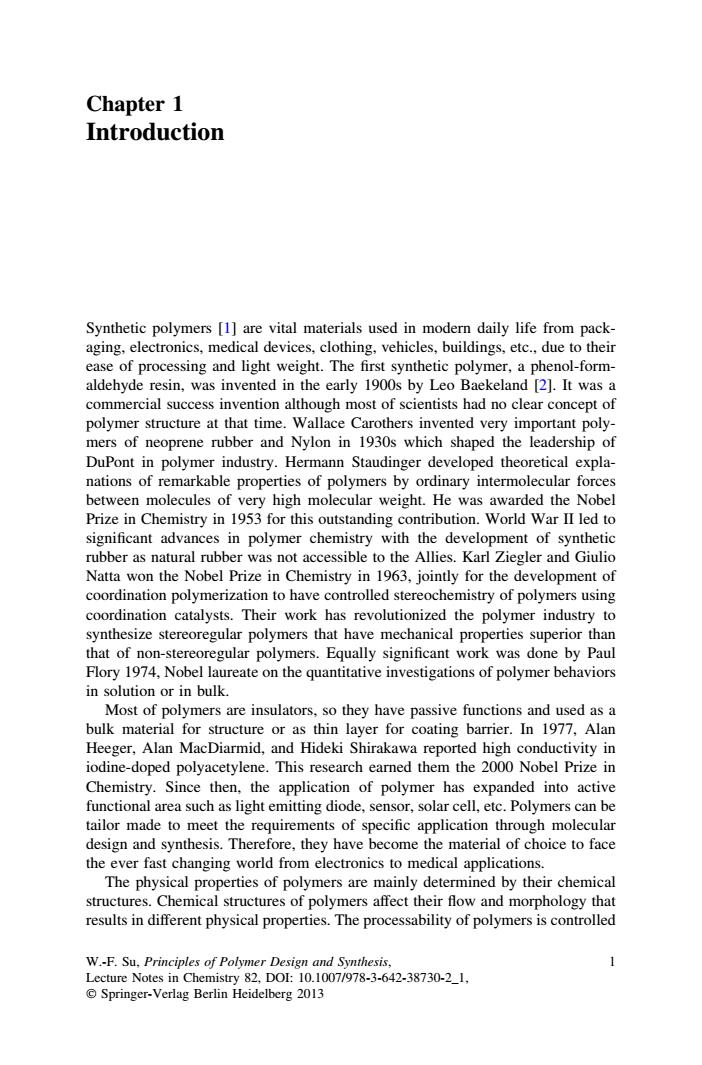正在加载图片...

Chapter 1 Introduction Synthetic polymers [1]are vital materials used in modern daily life from pack- aging,electronics,medical devices,clothing,vehicles,buildings,etc.,due to their ease of processing and light weight.The first synthetic polymer,a phenol-form- aldehyde resin,was invented in the early 1900s by Leo Baekeland [2].It was a commercial success invention although most of scientists had no clear concept of polymer structure at that time.Wallace Carothers invented very important poly- mers of neoprene rubber and Nylon in 1930s which shaped the leadership of DuPont in polymer industry.Hermann Staudinger developed theoretical expla- nations of remarkable properties of polymers by ordinary intermolecular forces between molecules of very high molecular weight.He was awarded the Nobel Prize in Chemistry in 1953 for this outstanding contribution.World War II led to significant advances in polymer chemistry with the development of synthetic rubber as natural rubber was not accessible to the Allies.Karl Ziegler and Giulio Natta won the Nobel Prize in Chemistry in 1963,jointly for the development of coordination polymerization to have controlled stereochemistry of polymers using coordination catalysts.Their work has revolutionized the polymer industry to synthesize stereoregular polymers that have mechanical properties superior than that of non-stereoregular polymers.Equally significant work was done by Paul Flory 1974,Nobel laureate on the quantitative investigations of polymer behaviors in solution or in bulk. Most of polymers are insulators,so they have passive functions and used as a bulk material for structure or as thin layer for coating barrier.In 1977,Alan Heeger,Alan MacDiarmid,and Hideki Shirakawa reported high conductivity in iodine-doped polyacetylene.This research earned them the 2000 Nobel Prize in Chemistry.Since then,the application of polymer has expanded into active functional area such as light emitting diode,sensor,solar cell,etc.Polymers can be tailor made to meet the requirements of specific application through molecular design and synthesis.Therefore,they have become the material of choice to face the ever fast changing world from electronics to medical applications. The physical properties of polymers are mainly determined by their chemical structures.Chemical structures of polymers affect their flow and morphology that results in different physical properties.The processability of polymers is controlled W.-F.Su,Principles of Polymer Design and Synthesis, 1 Lecture Notes in Chemistry 82,DOI:10.1007/978-3-642-38730-2_1, Springer-Verlag Berlin Heidelberg 2013Chapter 1 Introduction Synthetic polymers [1] are vital materials used in modern daily life from packaging, electronics, medical devices, clothing, vehicles, buildings, etc., due to their ease of processing and light weight. The first synthetic polymer, a phenol-formaldehyde resin, was invented in the early 1900s by Leo Baekeland [2]. It was a commercial success invention although most of scientists had no clear concept of polymer structure at that time. Wallace Carothers invented very important polymers of neoprene rubber and Nylon in 1930s which shaped the leadership of DuPont in polymer industry. Hermann Staudinger developed theoretical explanations of remarkable properties of polymers by ordinary intermolecular forces between molecules of very high molecular weight. He was awarded the Nobel Prize in Chemistry in 1953 for this outstanding contribution. World War II led to significant advances in polymer chemistry with the development of synthetic rubber as natural rubber was not accessible to the Allies. Karl Ziegler and Giulio Natta won the Nobel Prize in Chemistry in 1963, jointly for the development of coordination polymerization to have controlled stereochemistry of polymers using coordination catalysts. Their work has revolutionized the polymer industry to synthesize stereoregular polymers that have mechanical properties superior than that of non-stereoregular polymers. Equally significant work was done by Paul Flory 1974, Nobel laureate on the quantitative investigations of polymer behaviors in solution or in bulk. Most of polymers are insulators, so they have passive functions and used as a bulk material for structure or as thin layer for coating barrier. In 1977, Alan Heeger, Alan MacDiarmid, and Hideki Shirakawa reported high conductivity in iodine-doped polyacetylene. This research earned them the 2000 Nobel Prize in Chemistry. Since then, the application of polymer has expanded into active functional area such as light emitting diode, sensor, solar cell, etc. Polymers can be tailor made to meet the requirements of specific application through molecular design and synthesis. Therefore, they have become the material of choice to face the ever fast changing world from electronics to medical applications. The physical properties of polymers are mainly determined by their chemical structures. Chemical structures of polymers affect their flow and morphology that results in different physical properties. The processability of polymers is controlled W.-F. Su, Principles of Polymer Design and Synthesis, Lecture Notes in Chemistry 82, DOI: 10.1007/978-3-642-38730-2_1, Springer-Verlag Berlin Heidelberg 2013 1�